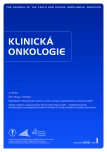The Incidence of Malignancies and Surveillance of Hematopoietic Stem Cells Donors – the Results of the Haemato-Oncology Department University Hospital in Plzen (Pilsen) and Czech National Marrow Donors Registry Observation
Authors:
S. Vokurka; V. Koza; A. Jungová; J. Navrátilová; T. Svoboda; P. Jindra; K. Steinerová; M. Hrabětová; R. Výrutová; L. Novák
Authors‘ workplace:
Hematologicko-onkologické oddělení, FN Plzeň
Published in:
Klin Onkol 2012; 25(1): 42-46
Category:
Original Articles
Overview
Backgrounds:
Granulopoesis colony-stimulating factor filgrastim is used to mobilize peripheral stem cells but there are concerns regarding an elevated risk of haematological malignancies. We analyzed the incidence of malignancies and the system of haematopoietic stem cells donor surveillance.
Patients and Methods:
prospective observation of sibling donors of the Haemato-Oncology Department University Hospital in Plzen (Pilsen) and of unrelated donors of the Czech National Marrow Donors Registry (CNMDR) in 2001–2010.
Results:
No malignancy was observed in a group of 344 unrelated CNMDR donors, providing 753 person-years; one case of chronic lymphocytic leukaemia manifested 6 years after bone marrow donation, with leukaemia clone retrospectively detected by DNA analysis in blood samples taken prior to the marrow donation. Acute myeloid leukaemia, non-Hodgkin lymphoma, renal and colorectal carcinoma were observed in a group of 84 peripheral stem cells sibling donors, providing 337 person-years observation. The respective incidence of the two haematologic malignancies was 593 cases and the expected incidence rate was 143 per 100,000. The sibling (related) donors age was significantly higher: 48 (16–75) vs. 31 (20–42) years, (p < 0.0001). Significantly more lost-to-follow-up donors were among the related donors (32% vs. 3%, p < 0.0001), even though active surveillance system was implemented.
Conclusion:
The development of malignancies in hematopoietic stem cells donors can naturally be expected. Related (sibling) donors are at higher risk because of their generally older age, and higher susceptibility to haematological malignancies developed within the family. The contribution of filgrastim exposure needs to be further investigated. The follow-up cooperation with related (sibling) donors is limited.
Key words:
filgrastim – incidence – grafts donors – acute myeloid leukaemia – lymphoma
The authors declare they have no potential conflicts of interest concerning drugs, products, or services used in the study.
The Editorial Board declares that the manuscript met the ICMJE “uniform requirements” for biomedical papers.
Submitted:
30. 6. 2011
Accepted:
23. 8. 2011
Sources
1. Kaplinsky C, Trakhtenbrot L, Hardan I et al. Tetraploid myeloid cells in donors of peripheral blood stem cells treated with rhG-CSF. Bone Marrow Transplant 2003; 32(1): 31–34.
2. Nagler A, Korenstein-Ilan A, Amiel A et al. Granulocyte colony-stimulating factor generates epigenetic and genetic alterations in lymphocytes of normal volunteer donors of stem cells. Exp Hematol 2004; 32(1): 122–130.
3. Marmier-Savet C, Larosa F, Legrand F et al. G-CSF-induced aneuploidy does not affect CD34+ cells and does not require cell division. Blood 2010; 115(4): 910–911.
4. Bennett CL, Evens AM, Andritsos LA et al. Haematological malignancies developing in previously healthy individuals who received haematopoietic growth factors: report from the Research on Adverse Drug Events and Reports (RADAR) project. Br J Haematol 2006; 135(5): 642–650.
5. Halter J, Kodera Y, Ispizua AU et al. Severe events in donors after allogeneic hematopoietic stem cell donation. Haematologica 2009; 94(1): 94–101.
6. Confer DL, Miller JP. Long-term safety of filgrastim (rhG-CSF) administration. Br J Haematol 2007; 137(1): 77–78.
7. Nařízení vlády, kterým se provádí zákon č. 285/2002 Sb., o darování, odběrech a transplantacích tkání a orgánů a o změně některých zákonů (transplantační zákon), č. 436/2002 Sb. a Vyhláška Ministerstva zdravotnictví, kterou se stanoví bližší podmínky posuzování zdravotní způsobilosti a rozsah vyšetření žijícího nebo zemřelého dárce tkání nebo orgánů pro účely transplantací (vyhláška o zdravotní způsobilosti dárce tkání a orgánů pro účely transplantací), č. 437/2002 Sb.
8. The World Marrow Donor Association (WMDA). Worldmarrow.org. Last update: 2011 June 06, cited 2011 June 23. Available from: http://www.worldmarrow.org/.
9. The Joint Accreditation Committee-ISCT (Europe) & EBMT (JACIE-EBMT). Jacie.org. Last update: 2011 June 22, cited 2011 June 25. Available from: http://www.jacie.org/.
10. The Surveillance, Epidemiology, and End Results (SEER) Program of the National Cancer Institute, Cancer statistics, Database: Incidence – SEER 17 (2000–2008). Last update 2011 May 5, cited 2011 June 16. Available from: http://www.seer.cancer.gov/.
11. Doubek M, Mayer J. Filgrastim a akutní myeloidní leukemie. Klin Onkol 2003; 16(4): 161–167.
12. Indrák K, Papajík T, Faber E et al. Kritická analýza dat o akutních a chronických leukémiích v Národním onkologickém registru České republiky. Klin Onkol 2007; 20 (Suppl 1): 132–141.
13. Pottern LM, Linet M, Blair A et al. Familial cancers associated with subtypes of leukemia and non-Hodgkin’s lymphoma. Leuk Res 1991; 15(5): 305–314.
14. Segel GB, Lichtman MA. Familial (inherited) leukemia, lymphoma, and myeloma: an overview. Blood Cells Mol Dis 2004; 32(1): 246–261.
15. Wang SS, Slager SL, Brennan P et al. Family history of hematopoietic malignancies and risk of non-Hodgkin lymphoma (NHL): a pooled analysis of 10 211 cases and 11 905 controls from the International Lymphoma Epidemiology Consortium (InterLymph). Blood 2007; 109(8): 3479–3488.
16. Dušek L, Mužík J, Gelnarová E et al. Incidence a mortalita nádorových onemocnění v České republice. Klin Onkol 2010; 23(5): 311–324.
Labels
Paediatric clinical oncology Surgery Clinical oncologyArticle was published in
Clinical Oncology

2012 Issue 1
Most read in this issue
- Venous Access Devices in Oncology
- Utilisation of Electrical Impedance Tomography in Breast Cancer Diagnosis
- Identification of Molecular Markers in Children with Acute Myeloid Leukemia (AML)
- Six-year Follow-up of a Patient with Multiple Angiomatosis Involving Skeleton, Thoracic and Abdominal Cavities and the Gut Wall
